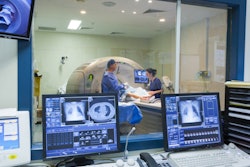
MR angiography (MRA) may have an edge over CT angiography (CTA) for diagnosing pulmonary embolism (PE) due to its reduced risk of radiation and adverse events, according to a pair of articles by Wisconsin researchers published online in Emergency Radiology and the Journal of the American College of Radiology.
 Dr. Michael Repplinger, PhD.
Dr. Michael Repplinger, PhD.
In older studies evaluating MRA for PE, the imaging modality did not perform that well due to marked variability in the technical quality of MR angiograms, co-first authors Dr. Michael Repplinger, PhD, and Dr. Scott Nagle, PhD, told AuntMinnie.com. Since then, there have been advances in MRI technology that enable more robust, faster, and higher-resolution imaging.
"In our study, outcomes following MR angiography were better than they were following CT angiography," Nagle said. "The technical success rate of the MR angiography exams in terms of the radiologist's confidence in interpretation was around 90% -- comparable to that of CT angiography, which means that with our technique for MR angiography, we have now overcome the major limitations seen in previous studies."
Comparing imaging modalities
The predominant technique for diagnosing PE in the U.S. involves using a series of clinical prediction rules to determine risk, followed by D-dimer testing and possibly CTA for patients who have a high pretest probability of PE. However, concern has been mounting in recent years about the low diagnostic yield of CTA for PE -- as well as any associated risks from radiation.
 Dr. Scott Nagle, PhD.
Dr. Scott Nagle, PhD.A promising alternative is to use a distinct set of clinical criteria known as the Pulmonary Embolism Rule-Out Criteria (PERC), which were designed to reduce unnecessary testing and imaging, especially for patients with a low risk of PE. Nevertheless, the usage rate of CT for PE has been on the rise -- increasing fivefold from 2000 to 2009.
One of the main reasons why clinicians continue to rely on imaging for the detection of PE is that many of its symptoms are nonspecific and a missed diagnosis can be fatal, according to the authors. Rather than eliminate imaging from the protocol, a more practical option may be to implement a different imaging exam that does not require ionizing radiation, such as MRA.
Along with colleagues at their institution, Repplinger and Nagle have been offering MRA as an alternative to CTA for the evaluation of PE, particularly in young women to minimize radiation exposure to the breast.
Seeking to determine the clinical effectiveness of MRA compared with CTA, they reviewed the medical records of emergency department patients who underwent an initial imaging exam with either one of the two modalities at their institution between April 2008 and March 2013.
In the first study, the researchers evaluated 592 MR angiography and 581 CT angiography cases matched by age and sex. They performed a search of the medical records for evidence of major adverse PE-related events -- including major bleeding, venous thromboembolism, and death -- within six months after initial imaging.
For the second study, the investigators examined the radiation risk and frequency of downstream imaging after MRA and CTA examination for the 717 emergency department patients who were negative for PE.
Fewer adverse events
Assessing the scans of 1,173 patients in the first study, the researchers found a comparable technical success rate for MR angiography and CT angiography in diagnosing PE, where success indicated the reading radiologist's confidence in interpretation using the scans. However, the proportion of major adverse events in patients who underwent MR angiography was 8.2% less than in those who had CT angiography.
| CTA vs. MRA for pulmonary embolism diagnosis | |||||
| CTA | MRA | p-value | |||
| Technical success rate in diagnosis of PE | 90.5% | 92.6% | 0.41 | ||
| Rate of adverse events within six months | 13.6% | 5.4% | < 0.01 | ||
| Follow-up imaging in first year | 15.3% | 16.7% | 0.26 | ||
| Average total radiation (including follow-up imaging) | 9.82 mSv | 2.92 mSv | -- | ||
This trend applied even when exclusively examining outpatients -- with major adverse events reported in 3.7% of MRA cases and 8% of CTA cases (p < 0.01). MRA was also associated with a lower percentage of equivocal results compared with CTA (3.9% vs. 6.9%; p = 0.03).
What's more, Repplinger, Nagle, and colleagues reported that the total amount of radiation associated with MRA exams including any downstream imaging within 30 days was an average of 6.9 mSv less than following CTA in the second study. And the cost of the streamlined MR angiography exams was within approximately 10% of the cost of the CT angiography exams.
They also found that nearly the same number of patients underwent follow-up imaging after an initial MRA exam compared with an initial CTA exam, and nearly an equal number of the repeat exams turned out to be from one of the two modalities. The time to follow-up scanning was not significantly different between the two tests.
Similar clinical effectiveness
Collectively, the two studies revealed that MR angiography and CT angiography offer a similar clinical effectiveness for the primary evaluation of suspected PE, although with a few key differences. Whereas MRA had a lower risk of major adverse events and no radiation exposure, CTA was slightly less likely to lead to early (within seven days) repeat imaging.
At 92.6%, the success rate of MRA in the researchers' first study far surpassed the 75% recorded in the Prospective Investigation of Pulmonary Embolism Diagnosis (PIOPED) III trial published in 2010.
MR angiography's superior performance in the current research is likely due to a combination of improved scanner technologies as well as the experience of radiologists and radiologic technologists at institutions well-versed in using the technique, Repplinger said. The group laid out its specific strategy for developing an effective MR angiography protocol for PE in a previous publication (European Journal of Radiology, March 2016, Vol. 85:3, pp. 553-563).
Regarding limitations of the study, the authors acknowledged that the preference of ordering physicians to request MRA primarily for younger female patients, who often had fewer comorbidities, possibly biased the results in favor of MRA.
The team has recently been exploring other ways to improve the diagnosis of PE. For cases involving patients who are sensitive or allergic to gadolinium, they have substituted the contrast agent with an iron-based agent (ferumoxytol). They have also been exploring the use of ultrashort echo time MRI to detect PE, which they believe may even outperform MR angiography.
Looking toward the future, they plan to continue addressing common challenges that arise when introducing a relatively newer imaging technique for PE diagnosis.
"The biggest issue that remains is whether this is going to be a Pandora's box -- leading to clinicians ordering scans willy-nilly since there's no radiation to be concerned about [with MR angiography]," Repplinger said.
"Success in this kind of endeavor and making it practical requires really close collaboration between emergency physicians and radiologists," Nagle said. "It can't be initiated in a one-sided fashion; both sides need to be invested. And I think that that's going to be the key from getting [MR angiography] out of mostly tertiary medical centers and into the community."



















